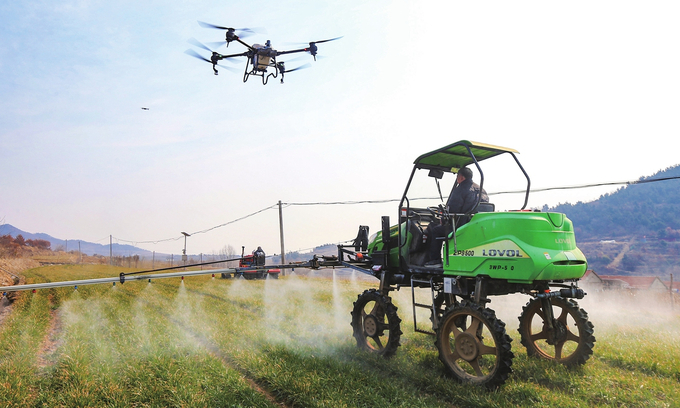June 21, 2025 | 01:24 GMT +7
June 21, 2025 | 01:24 GMT +7
Hotline: 0913.378.918
June 21, 2025 | 01:24 GMT +7
Hotline: 0913.378.918

Farmers drive agricultural machines and manipulate drones for spring plowing and prevention of wheat pests and diseases in a field in Rongcheng, East China's Shandong Province on February 23, 2023. China will strive to keep annual grain production over 650 billion kilograms this year, and develop modern agriculture infrastructure. Photo: cns
Jiao Shanwei, editor-in-chief of industry news website cngrain.com, told the Global Times on Sunday that the grain output goal was announced, based on experiences in previous years, which can satisfy the domestic demand.
The grain output goal, along with other economic development targets, was unveiled in the Government Work Report delivered by Premier Li Keqiang during the first session of the 14th National People's Congress which opened on Sunday.
The Government Work Report listed the food security as one of six key government jobs in 2023. China vowed to keep total grain acreage at a stable level and to launch a new drive to increase grain production by 50 million tons.
In addition, authorities will improve contingency plans for ensuring the provision of agricultural supplies at stable prices, and ramp up the development of high-standard crop-land, facilities for irrigation and water conservancy, and other agricultural infrastructure. Seed industry and agricultural science, technology and equipment will be invigorated, the Government Work Report showed.
In 2022, China's overall grain output reached 685 million tons, an increase of 3.7 million tons over 2021, which showed strong resilience despite the pandemic.
In the past five years, China kept stabilizing and increasing gain planting area, adding 30.4 million hectares of high-standard cropland. The rate of mechanization in crops plowing, planting, and harvesting increased from 67 percent to 73 percent.
China expanded domestic demand, promoted coordinated regional development and advanced people-centered new urbanization over the past five years, according to a government work report submitted to the national legislature for deliberation on Sunday.
China promoted personal income growth of urban and rural residents through various avenues, and the earnings of middle- and low-income groups have been rising, the report said. The country leveraged the fundamental role of consumption in stimulating economic growth and fostered a sound domestic demand system.
The country also worked to further improve its economic structure, such as by promoting digital economy. According to the report, the value-added output of new industries and new business forms and models took up over 17 percent of the GDP.
Guided by the principle that cities should be built by the people and for the people, China advanced people-centered new urbanization, which includes granting permanent urban residency to eligible people who move from rural to urban areas, said the report, adding that the country leverages the role of city clusters and metropolitan areas to promote coordinated development of large, medium and small cities.
In terms of promoting coordinated regional development, China made progress in the large-scale development of the western region, achieved new breakthroughs in the full revitalization of the northeastern region, accelerated the rise of the central region, and encouraged the eastern region to modernize more quickly. Overall, the central and western regions outpaced the eastern region in terms of economic growth rate, according to the report.
China will expand domestic demand and give priority to the recovery and expansion of consumption this year. The incomes of urban and rural residents will be boosted through multiple channels, and the growth in personal income will be generally in step with national economic growth, it said.
The government aims to drive investment with policy incentives and encourage the involvement of more private capital in major state projects, the report said. It proposed that 3.8 trillion yuan will be allocated for special-purpose bonds for local governments this year.
(Global Times: CGTN)

(VAN) Poultry production in Poland, which has only started recovering from devastating bird flu outbreaks earlier this year, has been hit by a series of outbreaks of Newcastle disease, with the veterinary situation deteriorating rapidly.

(VAN) Extensive licensing requirements raise concerns about intellectual property theft.

(VAN) As of Friday, a salmonella outbreak linked to a California egg producer had sickened at least 79 people. Of the infected people, 21 hospitalizations were reported, U.S. health officials said.

(VAN) With the war ongoing, many Ukrainian farmers and rural farming families face limited access to their land due to mines and lack the financial resources to purchase needed agricultural inputs.

(VAN) Vikas Rambal has quietly built a $5 billion business empire in manufacturing, property and solar, and catapulted onto the Rich List.

(VAN) Available cropland now at less than five percent, according to latest geospatial assessment from FAO and UNOSAT.

(VAN) Alt Carbon has raised $12 million in a seed round as it plans to scale its carbon dioxide removal work in the South Asian nation.